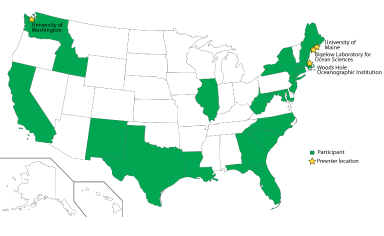Human activities release large volumes of carbon dioxide and other greenhouse gases that trap heat in the lower atmosphere and
affect the global climate. Springtime blooms of microscopic plants in the world's oceans absorb enormous quantities of carbon
dioxide, emitting oxygen via photosynthesis in the process. Whirlpools, or eddies, swirling across the surface of the ocean are
now believed to trigger these blooms, by sustaining phytoplankton in shallower waters where they can receive plenty of sunlight to
fuel their growth. This growth contributes to the oceanic uptake of carbon dioxide - about one third the amount discharged each
year through the burning of fossil fuels (the Atlantic alone is responsible for more than 20 percent of this uptake).
"The public pays for us and we owe them some feedback as to what we do. And it’s better to come in our own voices."-Eric D'Asaro |
This newly discovered mechanism helps explain the timing of the spring and summer blooms, offers a new look at why it has a patchy
appearance, and fills in another piece of the puzzle in our quest to better understand the consquences of global climate change.
"As science evolves, we learn, and our outlook of the world changes, "says Dr. Amala Mahadevan, one of Dr. Mary Jane Perry's
colleagues on the North Atlantic Bloom (NAB) Experiment. "It's imperative that scientists engage in education
and outreach because you can't expect people to change unless you convey to them why it's important to do so."
Mary Jane and her colleagues chose to disseminate information on the NAB Experiment via a five-part webinar series produced
by COSEE-Ocean Systems (COSEE-OS). An average of 24 attendees participated in each session (120 overall). Sixty-one unique
individuals tuned in and 46% of these participants attended more than one webinar. The webinars reached 21 U.S. States, Iceland,
Canada, and Germany and the audience consisted of a mix of formal educators (30%), informal educators (21%), faculty/researchers
(22%), and graduate students (9%). "I was impressed by the quality of the questions that they asked," says Mary Jane. "I
couldn't tell if they were teachers or oceanographers [who asked them]."
The webinars are archived
online, along with the
presentations and related materials (concept maps, dataset activities, etc.). In the year following the conclusion of the webinars,
this archive constituted the second most visited pages on the COSEE-OS website (second only to the home page).
As of March 2013, over 5,800 page views had been generated, and the related dataset activities had been downloaded more than 150 times,
thereby further increasing the reach of this project.





